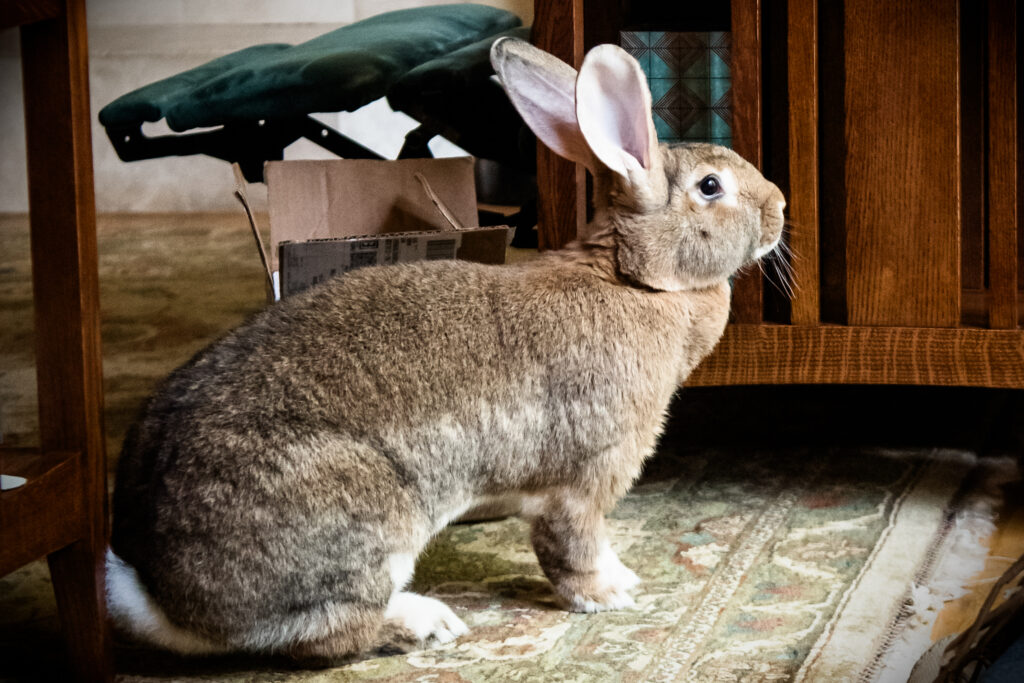By becoming familiar with our rabbits’ physical functions and by reading what their bodies tell us, we can use the right preventive care. Being aware of their fragile skeletons, we learn proper handling and avoid broken bones. Knowing that bunnies protect their bones with strong muscles, we allow them sufficient muscle-building exercise. By understanding what happens in their gastro-intestinal tract, we avoid many problems and enable our bunnies to maintain healthy digestion. In looking at a rabbit’s torso, you will see the enormous amount of space that is allocated to digestive function. The previous chapter dealt with what to feed your rabbit for nutrition. $is section explains how that food is processed.
Digestive Processing
The way rabbits digest their food is truly amazing. Though rabbits churn food in their stomach the same way as other animals, their inte%ines handle it quite differently.
The small intestine, which is very long in a rabbit, absorbs sugars, starches, protein, and most nutrients. Dietary fiber keeps material ‘owing through the small intestine to the cecum and colon, where it is processed according to size.
The cecum is the large fermenting vat filled with beneficial food-digesting bacteria and protozoa. It produces volatile fatty acids, which are absorbed directly into the bloodstream. the cecum pushes out large particles, while retaining small cellulose particles, along with excess sugar, starch, and protein from the small intestine. A portion of the cecal contents is emptied daily. The cecum empties at a slower rate when dietary fiber is low.
The colon, or large intestine, does some unique things in rabbits. In addition to forming fecal pellets, it separates small particles and sends them backwards into the cecum. Large &ber particles are sent on their way from here for a quick passage through the colon to become the large hard marbles that you see in your bunny’s litterbox.
Recycling Plan
At times, wild rabbits must survive on twigs and shrubs that are nutritionally low quality for other animals. $ey do this by consuming a large volume and converting it to higher quality protein and energy. $e cecum does this job by producing B-complex vitamins and protein to be reingested. $e vitamin⁄protein-rich material from the cecum is packaged into little clusters of cecotropes, which are an important part of your bunny’s diet. $ey are enclosed in a mucus-membrane coating, which protects cecotrope bacteria from stomach acid, allowing them to ferment several more hours in the stomach after they are reingested. Finally the cecotropes are ready to pass to the small intestine where the nutrients are absorbed.
That’s a pretty elaborate, round-about way of getting nourishment out of a blade of grass or the oak-tree bark (or your baseboard) that your bunny has been nibbling on, but it works for wild rabbits who must get the most out of the poor food sources that are available. Nature has designed for them this complicated plan of food processing and reprocessing to get maximum nutrients. Domestic rabbits, with the same physical design and much richer diets, can easily gain excessive weight.
Digestive Disorders
The rabbit GI (gastrointestinal) tract depends on dietary “ber to keep everything moving at full speed. When motility slows down or stops, the result can be life threatening. Most motility problems can be prevented by plenty of hay. But sometimes rabbits don’t consume the necessary “ber, because of stress, dental disorders, or other diseases, so it’s important to correct any underlying problems.
The old diagnosis of “hairball” was used to describe the accumulation of hair in the stomach. ! It is currently NOT thought to be a disease condition in itself. It becomes a problem only when motility stops, and the hair doesn’t pass.
Upper GI impactions and bloat. Sometimes a small dense plug of hair can get through the stomach and lodge in a narrow passage in the small intestine, usually at the duodenum. thee resulting obstruction stops the flow from the stomach.
Bloat is a serious condition that may develop secondary to impaction anywhere in the GI tract. “If these harmful bacteria continue to grow, they can produce deadly toxins…”
Gas can form directly behind a blockage or in any area where motility has slowed down, extending the stomach or the part of the intestine affected. Bloat can cause severe discomfort, shock, and death if not treated. In many cases, bloat occurs in the stomach itself, where immediate relief can be achieved with a gastric tube to remove gas. Treatment also includes pain medication and intravenous fluids to rehydrate and soften the impaction.
Altered gut flora. A rabbit relies on anaerobic bacteria (grown without oxygen) in the cecum to break down cellulose. If the microbial balance of the cecum is altered, an overgrowth of harmful bacteria may result that can make your bunny sick. And not only that—if these harmful bacteria continue to grow, they can produce deadly toxins that can kill your rabbit (enterotoxemia). Altered gut flora can be caused by moldy food, an overload of sugar or starch, or certain oral antibiotics. This is why veterinarians can prescribe only drugs for rabbits that work on the illness without destroying necessary digestive bacteria.
Enteritis (inflammation of the small intestine) can occur in rabbits when the cecum has slowed down enough to alter the gut flora. This affects the area of the small intestine (the ileum) next to the cecum. #e intestinal lining produces a mucus coating over the inflamed area.
Cecal impaction occurs when more low-fiber material enters the cecum than exits. Since the cecum empties at a slower rate when fiber intake is low, impaction is less likely on a high fiber diet.
Another cause of cecal impaction is dehydration. This may be due to hot weather or insufficient water intake. When fluids are needed elsewhere in the body, they are drawn from the cecum’s reservoir into the blood, leaving a hard accumulating mass in the cecum.
Any of the above conditions is usually accompanied by obvious pain, shown in bunny’s posture. Bunny will not want to eat or drink, thus contributing to the severity of the problem.
An excellent article can be read online for more detail on these conditions and treatment.
Litterbox Indicators
Your bunny’s digestion can be monitored via the litterbox. You should see healthy piles of regular dry round marbles. the following may indicate digestive trouble:
Small scanty droppings indicate that less is coming through the GI tract.
Ropes of hair with strung-together marbles may indicate that excessive hair is being swallowed.
Excessive soft clusters of cecotropes left unconsumed may simply mean that the diet is too protein rich.
Watery diarrhea means that digestion has already shut down.
Stasis episode: Buster’s x-ray indicated “large, fluid- filled stomach with gas bubble.” A secondary problem was azotemia. He fully recovered from both with treatment. RABBIT MEDICINE Radiograph: courtesy VCA, Oakland, CA 4. Dana Krempels, Mary Cotter and Gil Stanzione, “Illeus in Domestic Rabbits,” Exotic DVM 2, no.4 (2000) http://www.bio.miami.edu/hare/ileus.html 9.4
Notes
2. E.Sakaguchi, “Digesta retention and &bre digestion in brushtail possums, ringtail possums and rabbits.” Comparative Biochemistry and Physiology 96A :351(1990)
3. Susan Brown, “Sluggish Motility in the Gastro-intestinal Tract,” House Rabbit Journal III, no. 7 (1996) http://rabbit.org/sluggish-motility-in-the-gastrointestinal-tract-2/
©Copyright Marinell Harriman. All Rights Reserved. Republished with the permission of the author.
Physical Design was originally published in House Rabbit Handbook (5th ed.).

